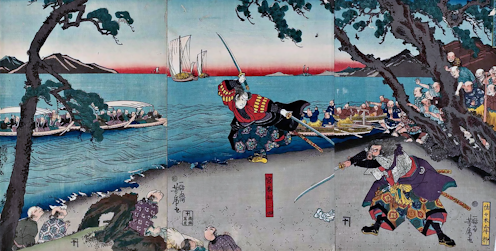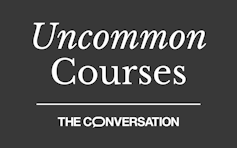What is the ‘way of the warrior’? Students investigate the arts of war and peace in this course abou
The study of martial arts involves physical training − but also raises larger questions about ethics and what justifies the use of force.


Uncommon Courses is an occasional series from The Conversation U.S. highlighting unconventional approaches to teaching.
Title of course:
The Way of the Warrior
What prompted the idea for the course?
I am a lifelong martial artist who grew up training in both taekwondo and karate. During a pivotal point in graduate school, I realized that the study of martial arts helped me better understand political philosophy – and that revelation inspired this course.
Southern California contains a unique hub of martial artists, many of whom studied with Bruce Lee. When I was working on my doctorate at The Claremont Colleges, I discovered an exceptional school just down the street from campus and began to study Filipino martial arts, Lee’s Jeet Kune Do, and Rickson Gracie Jiu Jitsu. My teacher, Guro Jason Cruz, refined the method of training the body with the training of the mind in a way that is still unmatched.
At the time, I was studying political philosophy and education in ancient Greece, including the significance of the “palaestra” and the “gymnasia,” which were sites for boxing, wrestling and the pankration – a practice akin to mixed martial arts today – but also intellectual cultivation.
The intensity of my own training helped me gain a deeper understanding not only of Greek warrior culture but also for the study of martial arts and its relationship to philosophy: physical and intellectual development were both indispensable in a virtuous life.
After I started teaching at Hamilton, I created this course to compare different views of warrior ethics.
What does the course explore?
Our class investigates the ways of life for warriors and the ethical codes that emerge in their political communities. We compare themes such as virtue, or human excellence, justice, life and death, while looking at Western and non-Western views in dialogue.
Aristotle, for example, emphasized the truly noble and good human being: someone who had achieved complete virtue and deserved the greatest goods, such as honor. Yamamoto Tsunetomo, describing “Bushido,” the code of the Japanese samurai in the 18th century, prioritized being prepared to die and serving one’s lord in the pursuit of honor.
One crucial issue we examine is whether the true “way of the warrior” really involves destruction or is finally about something akin to the power of love. One might presume that the warrior way requires killing, but we challenge that assumption and consider whether there are higher principles at stake. To paraphrase Morihei Ueshiba, the founder of aikido, in injuring others, do you injure yourself?
Why is this course relevant now?
The use of violence and the ethics of war are perennial issues. In particular, conflicts are oftentimes initiated, prolonged or supported by people who have no experience with battle, fighting or even sparring.
One way people can take debates over the use of violence more seriously, and whether force is justified when responding to injustice, is by paying close attention to the writings of these experienced warriors and philosophers.
What will the course prepare students to do?
Ultimately, the course connects back to the overarching concept of liberal education: Are the principles we discuss in class universal? Are the arts of war and peace useful in other pursuits?
For example, the works of Sun Tzu, the ancient Chinese general, and Miyamoto Musashi, the undefeated samurai, are frequently read in economics and business.
Musashi stated that the way “is based on excelling others in anything and everything,” a character made “possible by the power of martial arts.” We discuss whether that is how we should approach our entire lives.
Finally, the class reflects on whether engaging with these texts from other times and places can liberate us – whether this learning process can expand our horizons beyond popular ideas today.
Kenneth Andrew Andres Leonardo is co-founder and co-owner of Kali Method L.A. (Los Angeles). He is an Instructor in Kali Method under Guro Jason Cruz and also currently trains in Gracie Jiu Jitsu under Sensei Erik Soderbergh. Previously, he studied Pangamot under Felix Pascua.
Read These Next
School shootings dropped in 2025 - but schools are still focusing too much on safety technology inst
Prevention methods like lockdown drills do not account for many scenarios, including the likely case…
A, B, C or D – grades might not say all that much about what students are actually learning
Grades can magnify inequities that exist in American schools, making it harder for some students to…
If tried by court-martial, senator accused of ‘seditious behavior’ would be deprived of several cons
US Sen. Mark Kelly correctly articulated military law when he said service members have a duty to not…





